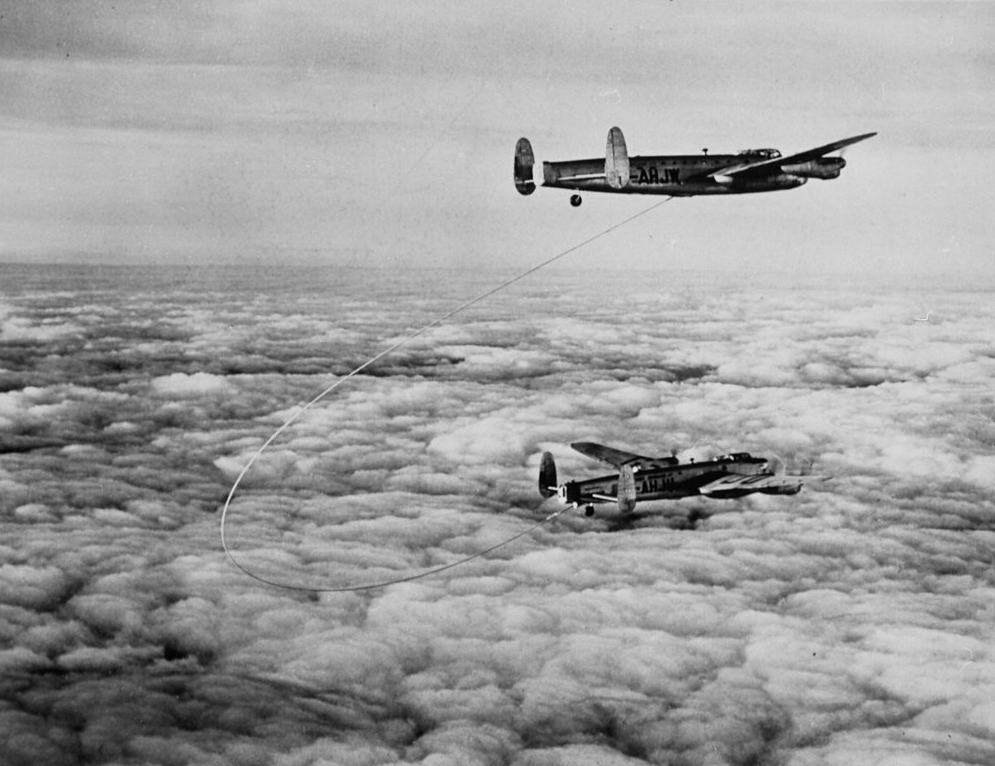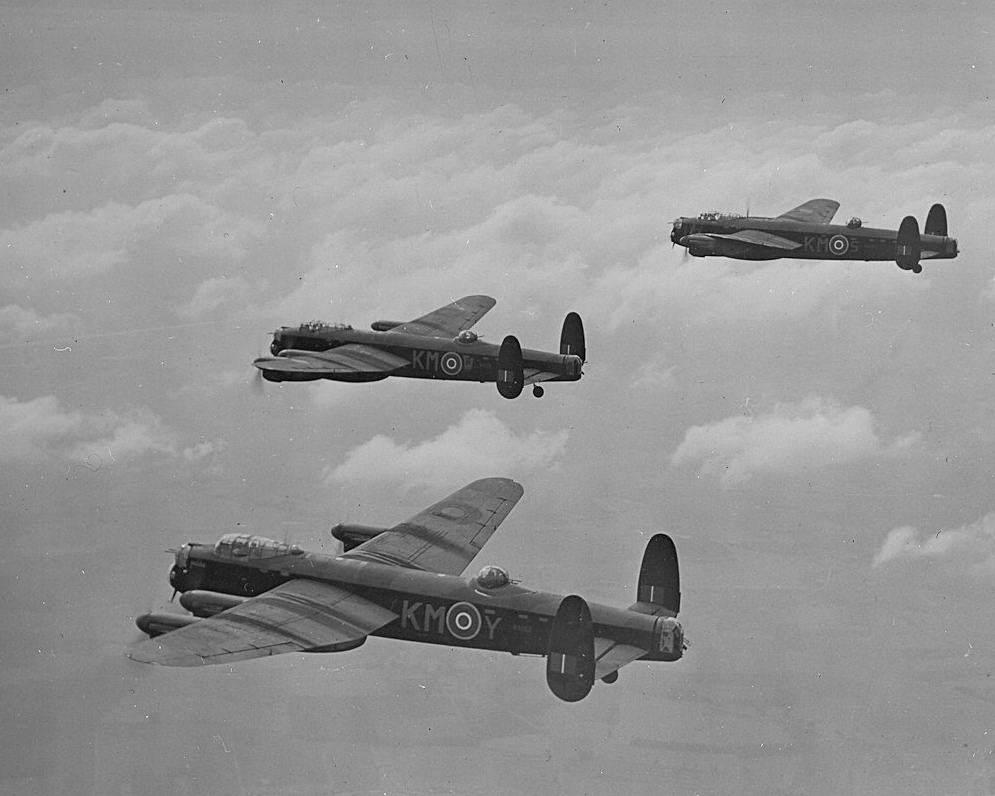The mid-upper gunner was provided with twin rifle-calibre Browning machine guns in a Frazer-Nash turret usually firing only ‘ball’ ammunition without tracer. His hydraulically operated turret possessed a 360-degree traverse with taboo track to prevent him firing at parts of his own aircraft in the heat of action. The rear gunner was located within an enclosed cylindrical turret with hinged doors at his back (to bail out he simply turned his turret sideways and pushed himself backwards through these doors). Almost throughout the war the tail Frazer-Nash turret was armed with four 0.303in Browning, although later on some aircraft were fitted with enlarged Rose turrets mounting two 0.5 Browning guns. The ammunition boxes for the rear turret were located approximately aft the mainplane trailing edge with long chutes passing down each side of the rear fuselage to a point under the centre of the turret mounting ring.
So much then for the duties of a Lancaster crew. Mere words can give no more than an impression of these duties in the reality of a dark night in a hostile sky. No amount of training could fully condition these young men to the sudden onset of unseen dangers, death and destruction and constant fear.
It was not uncommon for news of a raid to be received twelve hours before take-off, a period of daylight in which the aircrew could do little but try to rest and relax. Elsewhere however the bomber base would be seething with activity. Daylight hours were spent in the countless preparations for the raid, during which the base was sealed off from the outside world for security purposes. While a small army of engine and airframe fitters exhaustively checked and re-checked every part of the aircraft itself, armourers examined and tested turrets and guns. At the bomb dump the loads to be carried were assembled with the various pyrotechnics and the bombs fused and loaded onto the trolleys for delivery to each aircraft at its distant dispersal bay. At the various sections of the base specialist officers worked out signaling procedures, examining weather forecasts and target information. Others assembled all the latest information on enemy defences and tactics, on diversion airfields and on other Bomber Command activity, such as spoof raids designed to distract German fighters. Elsewhere equipment stores were checking parachutes and other emergency kits.
It was fairly common for an RAF Bomber Command base to accommodate two Lancaster squadrons, each of which might be required to dispatch twenty aircraft on a night raid. Thus an evening’s effort would involve some 280 aircrew members. The preparation of their aircraft demanded a carefully co-ordinated timetable of preparation in case an air test was required after an aircraft’s inspection.
Pre-raid briefing of all aircrew was undertaken by a number of specialists, introduced by the station commander, namely the armament officer, navigation officer, intelligence officer, signals officer and meteorological officer. The following raid was one of many launched during the war against Berlin – ‘the Big City’ – the Bombers’ track lying out across the North Sea before turning south-east across northern Germany towards the target. Window was to be dropped before crossing the enemy coast and for much of the remainder of the outward journey. Most of the bombers carried a single ‘Blockbuster’ and incendiary bombs for a typical ‘area bombing’ attack. The high explosive bomb was intended to smash the city’s water and electricity services and block streets with rubble, thereby preventing the civil defence forces from reaching the countless fires started by the tens of thousands of incendiaries. Diversionary raids were to be carried out by small forces of bombers against southern Norway and France in attempts to disperse the German fighter opposition.
The main briefing over, the various crewmembers dispersed to their own briefings and then to their messes for an evening meal. After donning their flying clothing in the locker rooms and collecting their personal safety equipment and flight snacks, they made their way to their dispersed aircraft – often well over a mile from the station buildings - to await the moment to embark. With the knowledge of a long, hazardous flight ahead, this waiting time strained the nerves to the utmost. Some crews played football with the ground personnel; others played cards, smoked a cigarette or even tried to snatch a few moments’ sleep.
About half an hour before take-off each crew assembled at the rear of the Lancaster to enter the aircraft through the door on the starboard side. A quick final check of their personal equipment and each man climbed the short ladder and made his way to his crew station. Those in the nose probably barked a shin on the great wing spar that constricted the midships passageway. As each man carried out his pre-flight checks, the pilot and flight engineer prepared to start the engines.
It was customary to start the two inboard engines first, followed by the outer. The ground starter battery was plugged in and the ground/flight switch set to ‘ground’, throttle set about half-an-inch open, propeller pitch set fine, slow-running switches off, supercharger in M-gear, air-intake control on cold, radiator shutters in automatic and the fuel tank selector cock on No 2 tank. As the groundcrew operated the priming pump, the ignition and booster coil was switched on and the starter button pressed. As the engine gave a few preliminary bangs, the groundcrew continued to pump away until the Merlin picked up on the carburettor and fired regularly. This process was repeated on the other engines.
As darkness gathered over the station, the air was full of noise as eighty, 1,200hp Merlins started and each pilot ran up against the chocks to 1,500rpm to check the eight magnetos and then to 3,000rpm to check boost. Further checks followed, prior to taxying. Flaps were selected down and up, bomb doors checked closed, booster pumps off, radiator shutters open, brake pressure at least 250lb/sq in, altimeter set to airfield height, vacuum pumps for instrument panel showing minus 4 ½ lb/sq in and navigation lights on.
Waving away the chocks, the pilot gunned the throttles to move his 25-ton aircraft out of dispersal to join the queue of other Lancasters taxying slowly towards the end of the runway. No weaving was necessary as his view over the front turret was sufficient to see the aircraft ahead. A check call was made on the intercom to ensure all crew members were ready for take-off and that their equipment, including oxygen supply, was functioning satisfactorily. As each Lancaster turned onto the runway, it was cleared for take-off by a green Aldis light from the control tower (no radion could yet be used). Take-off checks included auto-pilot clutch in, cock out, DR compass set, pitot head heater on, trim set (elevator slightly forward, rudder and aileron neutral), propeller pitch fine. Fuel was checked (contents OK, master cocks on, selector cocks on No 2 tanks, crossfeeds off, booster pumps in and 2 tanks on). Superchargers were set in M air intakes at cold, radiator shutters on auto and flaps selected at about 15 degrees down.
On receiving take-off clearance, the pilot released the brakes and advanced the throttles slowly, the flight engineer assisting and leading with the port levers to check a slight tendency to swing to port. With throttles wide open and held there by the flight engineer and the engines at puls-9 boost and 3,000rpm, the pilot eased forward on the control column, at the same time applying fairly coarse right rudder to hold the swing. At around 100mph indicated airspeed, he began a firm but gradual backward pressure on the column and the Lancaster became airborne. Applying the brakes momentarily to stop the wheels spinning, the undercarriage was retracted and, after gaining at least 500 feet, the flaps were raised. Safety speed was about 125 mph indicated and once this speed was reached, the throttles were pulled back to give plus-6 boost and 2,850rpm for the initial climb to operating height.
The Norfolk coast was crossed and the H2S radar gave a clear indication of Yarmouth, enabling the navigator to make a rough check on the briefed wind speed and direction. At this time it was not realised in Bomber Command that the operation of the H2S equipment would be detected by the Germans at very long range, thereby giving ample warning of the assembly and approach of a large raid. Later on in the war, orders were given that the H2S should only be switched on as the enemy coast was crossed.
Soon the first wind information at the head of the bomber stream was passed back to Britain by the ‘windfinders’. This was collated and broadcast to the bombers following. The radio operator received the information and passed it to the navigator, who made the necessary adjustment to his course and informed the pilot.
Arriving at 22,000 feet the pilot throttled back slightly to maintain a speed of just over 200mph indicated. After about three hours’ flying the navigator warned that the change of course towards the German coast must be made shortly and gave the anticipatory instructions to the pilot. One by one the gunners asked permission to fire a short burst from their guns to clear any icing and the clatter of gunfire would be heard over the background hum in the crew’s earphones.
The turn towards the enemy coast was followed almost immediately by the first discharge of Window bundles. The bomb aimer started to push the brown paper packages down the chute, to be caught and burst open by the Lancaster’s slipstream. Notwithstanding this effective means of confusing the enemy’s radar, the pilot now warned his gunners to be particularly alert for enemy fighters.






